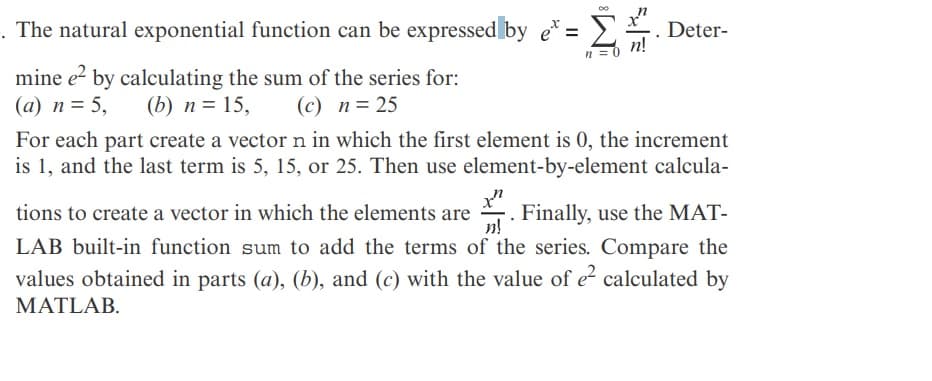The natural exponential function can be expressed by . Determine e2 by calculating the sum of the series for: (a) n = 5, (b) n = 15, (c) n = 25 For each part create a vector n in which the first element is 0, the increment is 1, and the last term is 5, 15, or 25. Then use element-by-element calculations to create a vector in which the elements are . Finally, use the MATLAB built-in function sum to add the terms of the series. Compare the values obtained in parts (a), (b), and (c) with the value of e2 calculated by MATLAB.
The natural exponential function can be expressed by . Determine e2 by calculating the sum of the series for: (a) n = 5, (b) n = 15, (c) n = 25 For each part create a vector n in which the first element is 0, the increment is 1, and the last term is 5, 15, or 25. Then use element-by-element calculations to create a vector in which the elements are . Finally, use the MATLAB built-in function sum to add the terms of the series. Compare the values obtained in parts (a), (b), and (c) with the value of e2 calculated by MATLAB.
Principles of Heat Transfer (Activate Learning with these NEW titles from Engineering!)
8th Edition
ISBN:9781305387102
Author:Kreith, Frank; Manglik, Raj M.
Publisher:Kreith, Frank; Manglik, Raj M.
Chapter4: Numerical Analysis Of Heat Conduction
Section: Chapter Questions
Problem 4.7P
Related questions
Question
The natural exponential function can be expressed by . Determine e2
by calculating the sum of the series for:
(a) n = 5, (b) n = 15, (c) n = 25
For each part create a
is 1, and the last term is 5, 15, or 25. Then use element-by-element calculations to create a vector in which the elements are . Finally, use the MATLAB built-in function sum to add the terms of the series. Compare the
values obtained in parts (a), (b), and (c) with the value of e2
calculated by
MATLAB.

Transcribed Image Text:The natural exponential function can be expressed by e* = 2.
Deter-
mine e? by calculating the sum of the series for:
(a) n= 5,
For each part create a vector n in which the first element is 0, the increment
is 1, and the last term is 5, 15, or 25. Then use element-by-element calcula-
(b) n= 15,
(c) n= 25
Finally, use the MAT-
n!
tions to create a vector in which the elements are
LAB built-in function sum to add the terms of the series. Compare the
values obtained in parts (a), (b), and (c) with the value of e calculated by
MATLAB.
Expert Solution
This question has been solved!
Explore an expertly crafted, step-by-step solution for a thorough understanding of key concepts.
This is a popular solution!
Trending now
This is a popular solution!
Step by step
Solved in 4 steps

Knowledge Booster
Learn more about
Need a deep-dive on the concept behind this application? Look no further. Learn more about this topic, mechanical-engineering and related others by exploring similar questions and additional content below.Recommended textbooks for you

Principles of Heat Transfer (Activate Learning wi…
Mechanical Engineering
ISBN:
9781305387102
Author:
Kreith, Frank; Manglik, Raj M.
Publisher:
Cengage Learning

Principles of Heat Transfer (Activate Learning wi…
Mechanical Engineering
ISBN:
9781305387102
Author:
Kreith, Frank; Manglik, Raj M.
Publisher:
Cengage Learning